
Homogeneous Catalysis
.pdfBIBLIOGRAPHY 83
Section 4.5
See references listed under 4.1 and 4.2, especially the articles by D. Forster.
Section 4.6
S. W. Polichnowski, J. Chem. Edu. 63, 206–9, 1986.
V. H. Agreda et al., Chemtech 22(3), 172–181, 1992; ibid. 18(4), 250–53, 1988.
Section 4.7
E.Drent et al., in Applied Homogeneous Catalysis with Organometallic Compounds
(see under Books), Vol. 2, pp. 1119–31.
Also see E. Drent et al., J. Organomet. Chem. 475, 57–63, 1994; ibid. 455, 247–53, 1993.
Section 4.8
M. Beller, in Applied Homogeneous Catalysis with Organometallic Compounds (see under Books), Vol. 1, pp. 148–58.
For phenyl acetic acid, see L. Casar, Chem. Ind. (Milan) 67, 256, 1985.
For ibuprofen, see J. N. Armor, Appl. Catal. 78, 141, 1991; J. Mol. Catal. A-Chem. 138(1), 25–26, 1999.
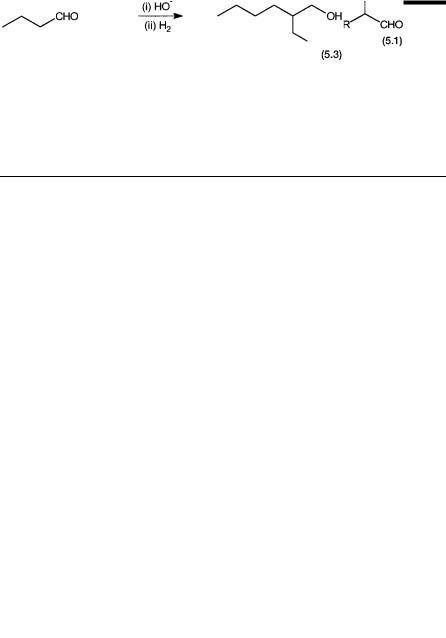
Homogeneous Catalysis: Mechanisms and Industrial Applications
Sumit Bhaduri, Doble Mukesh
Copyright 2000 John Wiley & Sons, Inc.
ISBNs: 0-471-37221-8 (Hardback); 0-471-22038-8 (Electronic)
CHAPTER 5
HYDROFORMYLATION
5.1BACKGROUND
Otto Roelen at Ruhrchemie AG discovered the hydroformylation or oxo reaction in 1938. As shown by reaction 5.1, the basic reaction is the addition of a hydrogen atom and a formyl group to the double bond of an alkene. The reaction works efficiently, mainly with terminal alkenes. With an optimal choice of ligands and process conditions, very high selectivity (>95%) for the desired isomer of the aldehyde could be achieved.
The aldehydes commercially produced this way are many. One of the most important is n-butyraldehyde. Isononyl aldehyde is also an important intermediate. As shown by reactions 5.2 and 5.3, propylene is hydroformylated to n-butyraldehyde which is then converted by aldol condensation and hydroge– nation to 2-ethyl hexanol.
85
86 HYDROFORMYLATION
Both 2-ethyl hexanol and isononyl alcohol are used, in combination with phthalic anhydride, as plasticizers for polyvinyl chloride resin. Hydroformylation is also used for the manufacture of long-chain fatty alcohols. The linear alcohols are used in detergents and are more biodegradable than the branched ones. The Shell higher olefin process (SHOP) uses ethylene that is oligomerized, isomerized, methathesized, and then hydroformylated to give long-chain fatty alcohols (see Section 7.4.1).
Three commercial homogeneous catalytic processes for the hydroformylation reaction deserve a comparative study. Two of these involve the use of cobalt complexes as catalysts. In the old process a cobalt salt was used. In the modified current version, a cobalt salt plus a tertiary phosphine are used as the catalyst precursors. The third process uses a rhodium salt with a tertiary phosphine as the catalyst precursor. Ruhrchemie/Rhone-Poulenc, Mitsubishi-Kasei, Union Carbide, and Celanese use the rhodium-based hydroformylation process. The phosphine-modified cobalt-based system was developed by Shell specifically for linear alcohol synthesis (see Section 7.4.1). The old unmodified cobalt process is of interest mainly for comparison. Some of the process parameters are compared in Table 5.1.
5.2THE RHODIUM PROCESS
The high selectivity and mild conditions make the rhodium process more attractive than the cobalt one for the manufacture of n-butyraldehyde. The high cost of rhodium makes near-complete catalyst recovery a must for the commercial viability of the process. As we shall see, this has been achieved by developing an elegant separation method based on water-soluble phosphines.
5.2.1The Catalytic Cycle
The catalytic cycle and the catalytic intermediates for the rhodium-plus- phosphine-based process are shown in Fig. 5.1. It is important to note that hydroformylation with rhodium can also be effected in the absence of phosphine. In such a situation CO acts as the main ligand (i.e., in Fig. 5.1, L = CO). The mechanistic implications of this is discussed later (Section 5.2.4).
The following points are to be noted. First of all, complexes 5.1, 5.3, 5.5, and 5.7 are 18-electron complexes, while the rest are 16-electron ones. Second, conversions of 5.3 to 5.4 and 5.5 to 5.6 are the two insertion steps. The selectivity towards n-butyraldehyde is determined in the conversion of 5.3 to 5.4. It is possible that a rhodium–isopropyl rather than rhodium–propyl complex is formed. In such a situation on completion of the catalytic cycle isobutyraldehyde will be the product. In practice both the n-propyl and the i-propyl complexes of rhodium are formed, and a mixture of n-butyraldehyde and i- butyraldehyde is obtained. This aspect is discussed in greater detail in the following section. Third, the catalyst precursor 5.1 undergoes ligand dissocia-
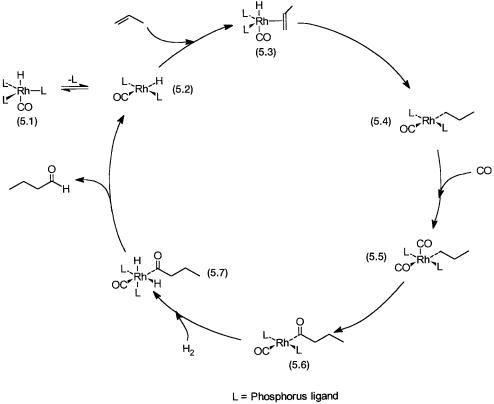
|
|
THE RHODIUM PROCESS |
87 |
|
TABLE 5.1 Process Parameters for Several Hydroformylation Processes |
|
|||
|
|
|
|
|
|
|
Cobalt |
|
|
Process parameters |
Cobalt |
phosphine |
Rhodium phosphine |
|
|
|
|
|
|
Temperature ( C) |
140–180 |
160–200 |
90–110 |
|
Pressure (atm) |
200–300 |
50–100 |
10–20 |
|
Alkane formation |
Low |
Considerable |
Low |
|
Main product |
Aldehyde |
Alcohol |
Aldehyde |
|
Selectivity (%) to |
75–80 |
85–90 |
92–95 |
|
n-butyraldehyde |
|
|
|
|
Isolation of catalyst |
Difficult; HCo(CO)4 |
Less difficult |
Less difficult; water-soluble |
|
|
is volatile |
|
phosphine a major |
|
|
|
|
advancement |
|
|
|
|
|
|
Figure 5.1 The basic catalytic cycle for the hydroformylation of propylene with Rh/ PPh3-based catalyst. In step 5.3 to 5.4 anti-Markovnikov addition is assumed.
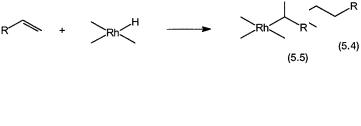
88 HYDROFORMYLATION
tion to generate 5.2, a coordinatively unsaturated species. Finally, conversion of 5.6 to 5.7 is an oxidative addition reaction, while the conversion of 5.7 to 5.2 occurs by reductive elimination.
5.2.2Product Selectivity
The two different ways of inserting an alkene into a metal–hydrogen bond, as shown by 5.4 and 5.5, are called anti-Markovnikov and Markovnikov addition, respectively. Insofar as hydroformylation with high selectivity to n-butyralde- hyde is concerned, it is considered to be primarily an effect of steric crowding around the metal center. The normal alkyl requires less space and therefore formed more easily than the branched one in the presence of bulky ligands.
However, the balance between sterically demanding ligands and their ability to remain coordinated so that the product selectivity could be influenced is a fine one. This aspect is discussed in more detail in Section 5.2.4. Although not directly related to hydroformylation, it is appropriate to note here that Markovnikov additions accompanied by -hydride elimination is a general pathway for alkene isomerization. This is shown in Fig. 5.2 for the isomerization of both terminal and internal alkenes.
5.2.3Mechanistic Studies
Kinetic studies are of limited value for elucidating the mechanism of the hydroformylation reaction. This is because the empirically derived rate expressions are valid only within a narrow range of experimental conditions. For the rhodium-catalyzed reaction, in the absence of phosphine, the following rate expression has been proposed:
d[RCHO] |
|
|
|
= k[Rh]a[alkene]b[H2]/[CO] |
(5.6) |
|
||
dt |
|
|
The value of b depends on the alkene, and both a and b under certain conditions may be less than one. The inverse dependence of rate on the concentration
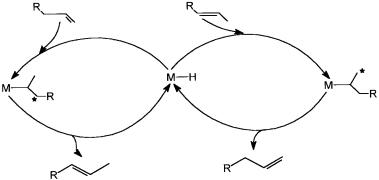
THE RHODIUM PROCESS |
89 |
Figure 5.2 Alkene isomerization by alkene insertion into the M–H bond followed by-hydride elimination. Note that the insertion is in a Markovnikov manner. The - carbons from which -hydride elimination leads to isomerization are marked by asterisks.
(pressure) of CO is observed only at total pressure exceeding 40 atm. At lower pressures the rate increases with increased pressure.
Industrially a large excess of the phosphine is used. This is necessary for good selectivity to n-butyraldehyde (see Section 5.2.4). On the basis of the mechanism proposed in Fig. 5.1, excess phosphine should reduce the reaction rate. This is because the precatalyst 5.1 must first undergo phosphine dissociation to initiate the catalytic cycle. The oxidative addition of dihydrogen to 5.6 is most likely the rate-determining step. Note that if we ignore the rate dependence on the phosphorus ligand, then the type of rate expression given by 5.6 is consistent with such a rate-determining step. The rate expression does indicate a transition state with interactions between rhodium and alkene, as well as rhodium and hydrogen.
Both in situ infrared and multinuclear NMR under less severe conditions have been used to gain mechanistic insights. For the hydroformylation of 3,3- dimethyl but-1-ene, the formation and hydrogenolysis of the acylrhodium species Rh(COR)(CO)4(R=CH2CH2But) can be clearly seen by IR. NMR spectroscopy has also been very useful in the characterization of species that are very similar to the proposed catalytic intermediates. We have already seen (Section 2.3.3, Fig. 2.7) NMR evidence for equilibrium between a rhodium alkyl and the corresponding hydrido–alkene complex. There are many other similar examples. Conversion of 5.3 to 5.4 is therefore well precedented. In the absence of dihydrogen allowing CO and alkene to react with 5.1, CO adducts of species like 5.6 can be seen by NMR. Structures 5.11 and 5.12 are two examples where the alkenes used are 1-octene and styrene, respectively.

90 HYDROFORMYLATION
The other isomer of 5.11 with one axial and one equatorial phosphine can also be seen at low temperature. Indeed at low temperature that appears to be the more stable isomer. With styrene, as shown by 5.12 the branched (Markovnikov) rather than the linear (anti-Markovnikov) isomer is the major one. However, remember that the experimental conditions of an actual industrial process, and that of the NMR experiments, are different.
Model compounds for some of the catalytic intermediates shown in Fig. 5.1 have also been synthesized and characterized. Thus trans-Rh(C2F4H)(CO)L2 is known, which may be considered as a model of 5.4. A model for 5.7, the complex 5.13, has also been made and characterized. While there are clear differences between 5.7 and 5.13, both 5.7 and 5.13 undergo reductive elimination. For the latter, the product of reductive elimination is acetaldehyde. This reaction has been kinetically studied to gain mechanistic insights.
5.2.4The Phosphorus Ligands and Selectivity
As has already been mentioned (Section 5.2.1), the catalyst precursor RhH(CO)L3 has to undergo ligand dissociation to generate an unsaturated, catalytically active intermediate. In the absence of phosphines CO is the main ligand of the various catalytically active intermediates. It is obvious, therefore, that in the presence of both CO and L there are several possible equilibria. Under mild conditions, the ones shown in Fig. 5.3 have been observed by multinuclear (1H, 13C, 31P) temperature-variable NMR.
In a typical industrial hydroformylation process, the rhodium to phosphorus molar ratio is between 1:50 to 1:100, while the partial pressure of CO is about
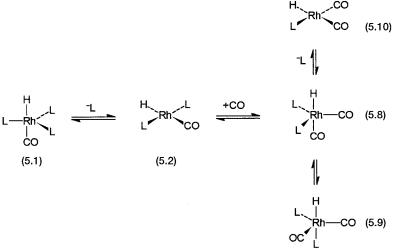
THE RHODIUM PROCESS |
91 |
Figure 5.3 Equilibria involving dissociation of L (L = PPh3). Note that 5.8 to 5.9 is an equilibrium that interchanges equatorial and axial ligands by Berry pseudorotation.
25 bar. It is reasonable to assume that under these conditions all the complexes with the general formula HRh(CO)nL4-n (n = 0–4) might be present with variable concentrations. Like HRh(CO)L3, the catalyst precursor in Fig. 5.1, all these species can undergo ligand dissociation and initiate catalytic cycles similar to the one already discussed. Indeed there are commercial hydroformylation processes where rhodium precatalysts are used without any phosphorous ligand (see Section 5.4). In such processes HRh(CO)4-derived catalytic intermediates take part in catalysis.
The individual catalytic cycles generated by HRh(CO)nL4-n species will be coupled with each other by ligand substitution reactions. This is shown in Fig. 5.4, where only the possible equilibria between the catalyst precursors (i.e., analogues of 5.1), the dissociated species (i.e., analogues of 5.2), and the alkene coordinated species (i.e., analogues of 5.3) are shown
It is obvious that such equilibria would exist for all the other catalytic intermediates. The result of all this is coupled catalytic cycles and many simultaneous catalytic reactions. This is shown schematically in Fig. 5.5. The complicated rate expressions of hydroformylation reactions are due to the occurrence of many reactions at the same time. As indicated in Fig. 5.5, selectivity towards anti-Markovnikov product increases with more phosphinated intermediates, whereas more carbonylation shifts the selectivity towards Markovnikov product. This is to be expected in view of the fact that a sterically crowded environment around the metal center favors anti-Markovnikov addition (see Section 5.2.2).
The use of bulky phosphorus ligands does not necessarily push the reaction towards the more phosphinated cycles. This is because too much steric crowd-
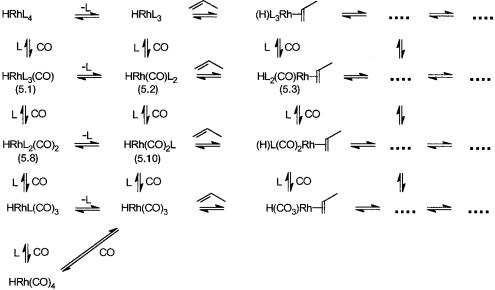
92 HYDROFORMYLATION
Figure 5.4 Some of the expected equilibria in the presence of large excess of L and CO. Only the analogues of 5.1, 5.2, and 5.3 are shown. The catalytic intermediates of the succeeding steps will occupy the vacant positions indicated by filled squares. Note that there is direct evidence for equilibrium between 5.1, 5.8, 5.2, and 5.10 from NMR.
ing around the metal center leads to phosphine dissociation. In such a situation the reaction in fact would be pushed towards cycles with less phosphinated intermediates, that is, towards Markovnikov addition. The above reasoning has been tested by using phosphorus ligands with different cone angles (see Section 2.1.2). Thus with the very bulky P(OC6H3-2,6-Me2)3, which has a cone angle >170 , the selectivity towards n-butyraldehyde is only about 50%. In contrast, P(OC6H5)3, which has a cone angle 128 , gives a selectivity of about 85%.
In summary, then, in the rhodium-catalyzed industrial process for propylene hydroformylation a high phosphine-to-Rh molar ratio is used. Under these conditions the use of a moderately bulky ligand such as triphenyl phosphine ensures that the catalysis takes place by the topmost cycles in Fig. 5.5, and n- butyraldehyde with high selectivity is produced.
5.2.5Water Soluble Phosphines and Rhodium Recovery
Rhodium is an expensive metal, and the commercial viability of the rhodiumbased hydroformylation process depends crucially on the efficiency of the catalyst recovery process. In the past this has been achieved either by a complicated recycle process or more commonly by energy-requiring distillation. A major advancement in catalyst recovery in recent years has been the introduc-
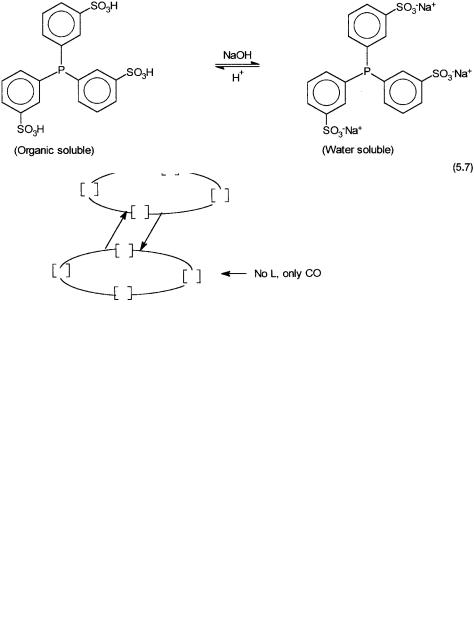
THE RHODIUM PROCESS |
93 |
Figure 5.5 Schematic drawing of catalytic cycles coupled by substitutions of L and CO. [ ] are the catalytic intermediates. Figure 5.4 and this figure are basically the same except in the former the cycles were not explicitly shown.
tion of a water-soluble phosphine by Ruhrchemie/Rhone-Poulenc. The phosphorus ligand used is trisulfonated triphenylphosphine, commonly referred to as TPPTS. As shown by 5.7, there is a pH-dependent equilibrium between the water-soluble and the organic-soluble forms of TPPTS.
The protonated form is extractable with organic solvents between pH 0 and1, while at higher pH the sodium salt is soluble in water to the extent of 1100 g/liter. The nontoxicity of the ligand (an oral LD50 5 g/kg) is another feature that makes its large-scale industrial use possible.
